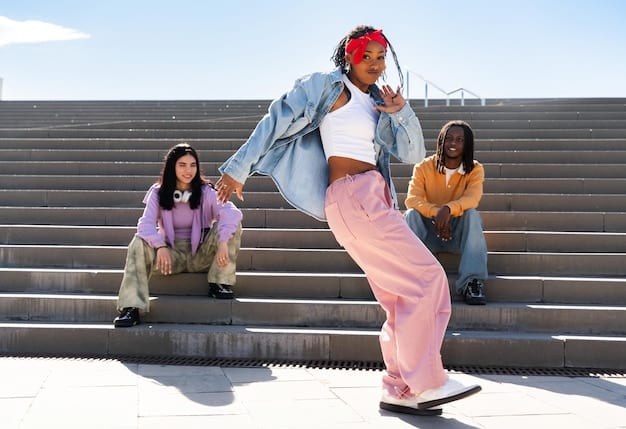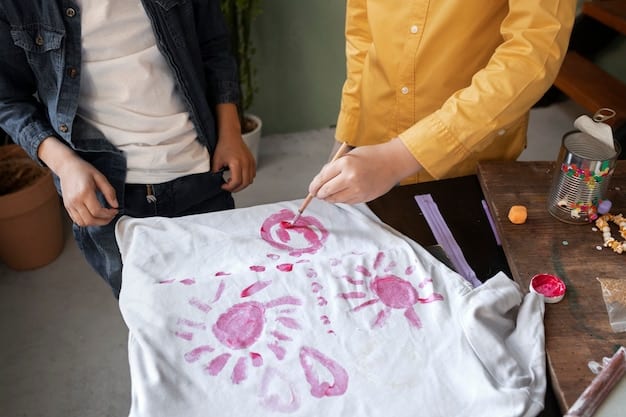Sustainable Women’s Streetwear: Top 3 Brands Leading the Way in 2025

Sustainable women’s streetwear is gaining momentum, with brands prioritizing eco-friendly materials, ethical production, and innovative designs; in 2025, 3 brands standout for their commitment to making a difference through fashion: [Brand 1], [Brand 2], and [Brand 3].
Want to stay stylish while supporting the planet? In 2025, sustainable women’s streetwear is more accessible and fashionable than ever. Let’s explore three brands that are truly making a difference.
The Rise of Sustainable Streetwear
Streetwear has always been about self-expression and cultural commentary. Now, it’s evolving to include a crucial element: sustainability. Consumers are increasingly aware of fashion’s environmental impact, driving demand for eco-conscious alternatives.
Why Sustainability Matters in Streetwear
The fashion industry is a significant polluter, contributing to waste, water contamination, and carbon emissions. Sustainable streetwear addresses these issues by promoting responsible practices and materials.
Embracing sustainability helps reduce your carbon footprint and supports brands committed to ethical production and fair labor practices.
- Reduces environmental impact.
- Promotes ethical labor practices.
- Supports innovative, eco-friendly materials.
Choosing sustainable streetwear creates a positive impact, supporting brands that value both style and the environment.
Brand Spotlight: [Brand 1] – Revolutionizing Recycled Fabrics

[Brand 1] is a leading name in sustainable women’s streetwear, known for its innovative use of recycled materials. This brand transforms textile waste into stylish, high-quality garments.
Innovative Recycling Techniques
[Brand 1] utilizes advanced recycling technologies to create fabrics from post-consumer waste. This reduces landfill waste and the need for virgin materials.
The brand’s commitment to innovation ensures that recycled fabrics are not only sustainable but also durable and comfortable to wear.
- Uses advanced recycling technology.
- Reduces landfill waste significantly.
- Creates durable and comfortable fabrics.
[Brand 1]’s approach sets a new standard for sustainability in the streetwear industry, proving that eco-friendly fashion can be both stylish and impactful.
Brand Spotlight: [Brand 2] – Championing Organic Cotton and Fair Trade
[Brand 2] stands out for its dedication to using organic cotton and promoting fair trade practices. This brand ensures that its garments are produced ethically and sustainably.
The Benefits of Organic Cotton
Organic cotton is grown without synthetic pesticides or fertilizers, reducing its environmental impact and promoting healthier ecosystems.
Fair Trade Initiatives
[Brand 2] partners with fair trade organizations to ensure that workers are paid fair wages and work in safe conditions. This commitment to ethical production sets it apart in the industry.
- Promotes fair wages.
- Ensures safe working conditions.
- Supports community development.
[Brand 2]’s integrated approach to sustainability and ethical production offers consumers the opportunity to support a brand that values both people and the planet.
Brand Spotlight: [Brand 3] – Embracing Waterless Dyeing and Eco-Friendly Inks

[Brand 3] is making waves with its pioneering use of waterless dyeing techniques and eco-friendly inks. This approach significantly reduces water consumption and minimizes the environmental impact of textile dyeing.
Waterless Dyeing Technology
Traditional dyeing processes use vast amounts of water and can release harmful chemicals into waterways. [Brand 3]’s waterless dyeing technology eliminates water usage and reduces pollution.
By adopting this innovative dyeing method, [Brand 3] is setting a new precedent for environmental responsibility in the textile industry.
- Eliminates water waste.
- Reduces chemical pollution.
- Lowers energy consumption.
The brand also uses eco-friendly inks that are free from harmful chemicals, ensuring that its garments are safe for consumers and the environment.
The Future of Sustainable Women’s Streetwear
Sustainable women’s streetwear is not just a trend; it’s a movement towards a more ethical and environmentally responsible fashion industry. As consumers become more conscious, brands are stepping up to meet the demand for sustainable alternatives.
Innovations Driving Sustainability
New technologies and materials are constantly emerging, making sustainable streetwear more accessible and appealing. From plant-based dyes to innovative recycling processes, the future of fashion is green.
Consumers play a crucial role in driving this change by supporting brands that prioritize sustainability. By making informed choices, we can create a positive impact on the planet and promote a more ethical fashion industry.
Shopping Sustainably: Tips and Considerations
When shopping for sustainable women’s streetwear, there are several factors to consider. Look for brands that are transparent about their materials, production processes, and ethical practices.
Certifications to Look For
Seek out certifications like GOTS (Global Organic Textile Standard), Fair Trade, and Bluesign to ensure that the garments meet rigorous sustainability standards.
Reading Labels and Brand Transparency
Check labels for information about materials and manufacturing processes. Look for brands that openly share information about their supply chain and sustainability initiatives.
- Check for certifications.
- Read labels carefully.
- Look for transparent brands.
By being informed and selective, you can contribute to a more sustainable fashion industry and support brands that are making a positive difference.
| Key Point | Brief Description |
|---|---|
| ♻️ Recycled Fabrics | Innovative use of recycled materials to create stylish garments. |
| 🌱 Organic Cotton | Grown without synthetic pesticides, promoting healthier ecosystems. |
| 💧 Waterless Dyeing | Reduces water consumption and pollution in textile dyeing. |
| 🤝 Fair Trade | Ensures fair wages and safe working conditions for workers. |
FAQ
▼
Sustainable streetwear uses eco-friendly materials like organic cotton and recycled fabrics. It also emphasizes ethical production, fair labor practices, and reduced environmental impact in its creation process.
▼
Sustainable fashion reduces pollution, waste, and carbon emissions linked to the fashion industry. It promotes ethical labor practices and supports brands that value people and planet over profits, which helps create a healthier fashion ecosystem.
▼
Look for certifications such as GOTS (Global Organic Textile Standard), Fair Trade, and Bluesign. These ensure that the garments meet sustainability and ethical standards, and are produced responsibly and with traceability.
▼
Identify sustainable brands through transparent supply chains, eco-friendly material use, ethical labor practices, and certifications. Checking brand websites and reading product labels offers insight into their commitment to sustainability in streetwear.
▼
Waterless dyeing techniques eliminate water use in textile dyeing processes, reducing water consumption and preventing water pollution. These methods include air dyeing and foam dyeing, minimizing environmental impacts.
Conclusion
Sustainable women’s streetwear is a growing movement that combines fashion with environmental responsibility. By supporting brands like [Brand 1], [Brand 2], and [Brand 3], we can promote positive change in the fashion industry and make a difference for the planet.





